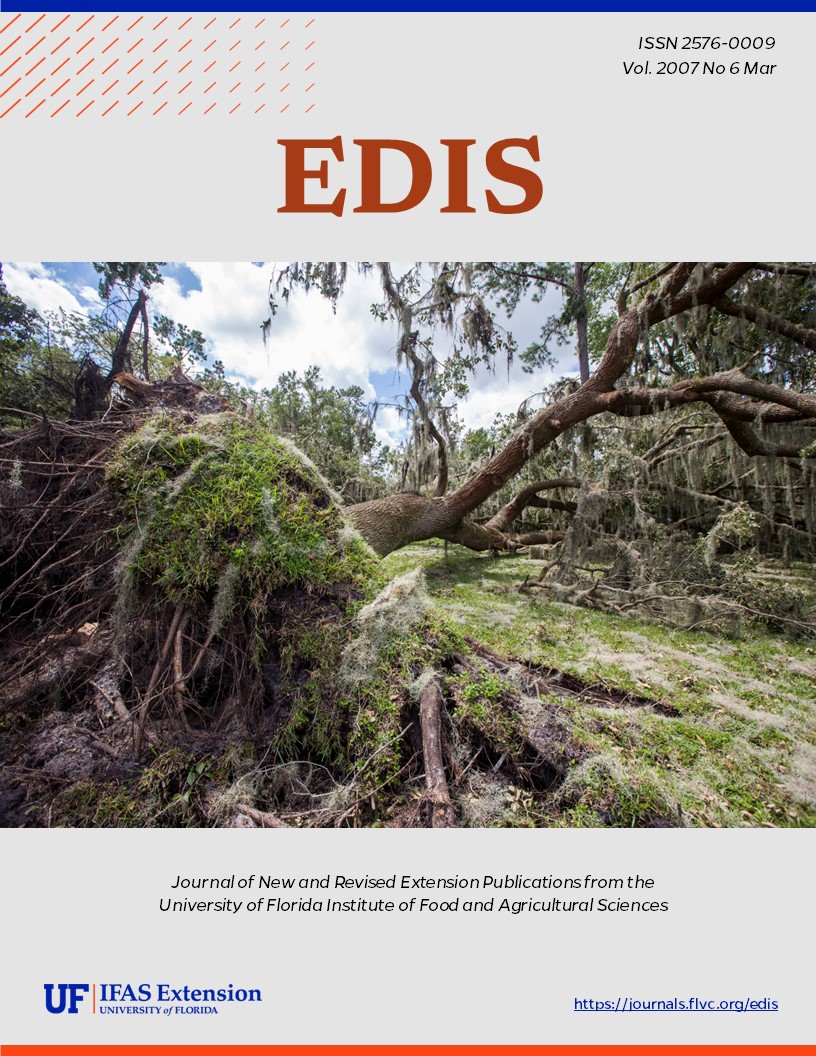Abstract
EENY-388, a 7-page illustrated fact sheet by Jeffrey M. Eickwort, Albert E. Mayfield III, and John L. Foltz, describes three species of pine bark beetles in the genus Ips -- the sixspined ips, I. calligraphus (Germar); the eastern fivespined ips, I. grandicollis (Eichloff); and the small southern pine engraver, I. avulsus (Eichloff) -- which live predominantly in the inner bark of stressed pines in the southern United States, where they breed and feed on phloem tissue. Includes selected references. Published by the UF Department of Entomology and Nematology, September 2006.
References
Anderson NH, Anderson DB. 1968. Ips bark beetle attacks and brood development on a lightning-struck pine in relationship to its physical decline. Florida Entomologist 51: 23-30. https://doi.org/10.2307/3493669
Anderson RF. 1948. Host selection by the pine engraver. Journal of Economic Entomology 41: 596-602. https://doi.org/10.1093/jee/41.4.596
Anderson RF. 1977. Dispersal and attack behavior of the southern pine engraver Ips grandicollis Eichh., Coleoptera, Scolytidae. Pg. 17-23 In Technical Bulletin 310. Technical Bulletin of the Agricultural Experiment Station, University of Minnesota.
Connor MD, Wilkinson RC. 1983. Ips bark beetles in the South. USDA Forest Service, Washington, D.C. Forest Insect & Disease Leaflet 129. 8 p.
Coulson RN, Witter JA. 1984. Forest Entomology: Ecology and Management. John Wiley & Sons, Inc. 315-318.
Dixon WN. 1984. Ips engraver beetles. FDACS, Division of Forestry. Forest and Shade Tree Pests Leaflet No. 2. 2 p.
Kinn DN. 1986. Studies on the flight capabilities of Dendroctonus frontalis and Ips calligraphus: preliminary findings using tethered beetles. USDA Forest Service Research Note SO-324. 3 p. https://doi.org/10.2737/SO-RN-324
Kopper BJ, Klepzig KD, Raffa KF. 2004. Components of antagonism and mutualism in Ips pini-fungal interactions: relationship to a life history of colonizing highly stressed and dead trees. Environmental Entomology 33: 28-34. https://doi.org/10.1603/0046-225X-33.1.28
Lovelady CN, Pulley PE, Coulson RN, Flamm RO. 1991. Relation of lightning to herbivory by the southern pine bark beetle guild (Coleoptera: Scolytidae). Environmental Entomology 20: 1279-1284. https://doi.org/10.1093/ee/20.5.1279
Mason RR. 1970. Comparison of flight aggregation in two species of southern Ips (Coleoptera: Scolytidae). Canadian Entomologist 102: 1036-1041. https://doi.org/10.4039/Ent1021036-8
Miller MC. 1983. Lightning strike simulation for studying southern pine bark and engraver beetle attacks. USDA Forest Service Research Note SO-296. 4 p. https://doi.org/10.2737/SO-RN-296
Thatcher RC, Barry PG. 1982. Southern pine beetle. USDA Forest Service, Washington, D.C. Forest and Disease Leaflet No.49. 7 p.
Thatcher RC, Coster JE, Payne TL. 1978. Southern pine beetles can kill your ornamental pine. USDA Forest Service, Combined Forest Pest Research Development Program, Washington, D.C. Home and Garden Bulletin 226. 15 p.
USDA Forest Service. 1985. Insects of Eastern Forests. Miscellaneous Publication No. 1426. Washington, DC. 358-359.
Vité JP, Bakke A, Renwick JA. 1972. Pheromones in Ips (Coleoptera: Scolytidae): occurrence and production. Canadian Entomologist 104: 1967-1975. https://doi.org/10.4039/Ent1041967-12

